Tours
Create your tour or excursion in the proposed locations.
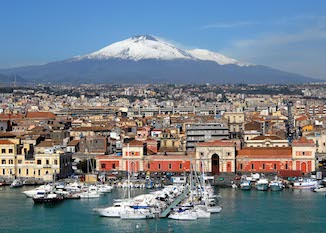
Catania
It is the second largest municipality for population in Sicily after Palermo and the centre of the largest conurbation in Sicily. It is one of the fifteen Italian metropolitan cities, the tenth of the Italian cities for population and also the most populous non-capital city of Italy.Founded in 729 B.C. by Calcidesi, has a long history characterized by several dominations whose ruins today contribute to enrich the artistic, architectural and cultural heritage.
Under the Aragonese dynasty, Catania was the capital of the Kingdom of Sicily. In the past centuries, it has been repeatedly affected by volcanic eruptions (the most impressive, in historical times, is the one of 1669) and earthquakes (the most catastrophic ones were those of 1169 and 1693).
The baroque style of its historical centre has been declared in 2002 UNESCO World Heritage Site, together with the seven municipalities of the Val di Noto (Caltagirone, Militello in Val di Catania, Modica, Noto, Palazzolo Acreide, Ragusa and Scicli).
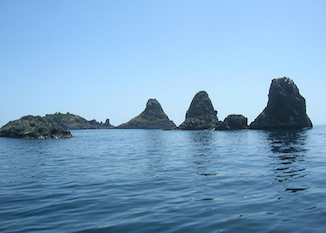
Riviera dei Ciclopi
The name of a shepherd by the name of Aci, Galatea love, graceful nymph who lived in the woods on the slopes of Etna, is the theme of this territory located near the coast of the Ionian sea and rugged lava. Acireale, Acicastello and Acitrezza, remember the name of the young man, who was killed out of jealousy by Polyphemus, who was turned into a river by the piety of Neptune to be able to still meet with the love. The Cyclops Riviera is characterized by a lava coast, created with the countless eruptions of Etna, overlooking a deep sea and transparent. The coast line is arched near Acireale, where it reaches a height of 120 feet above the sea, taking the name of "Timpa". Then back down again, always with his rough appearance blackish, and is remembered as the Riviera of the lemons because of the extraordinary spectacle of lush citrus visible on the sides of the road.
Fishing village, it should be visited the ancient medieval manor house, which includes a Museum with archaeological finds from the Palaeolithic to the Middle Ages and a collection of minerals. From its terraces you can see the village of Acitrezza, in front of which emerge from the sea stacks, tall, pointy rocks of black basalt, together with the island Lachea.
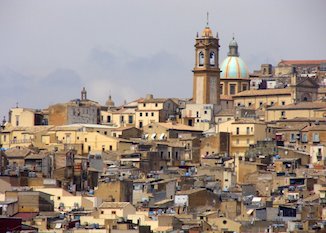
Caltagirone
Its ancient origin is attested by finds and numismatic and artistic documents that reveal it as one of many cities sicane or Sicilian or Sicilian-greek. Even in the territory have found coins Greek and Sicilian, in addition to the rich ceramic and metallic which is located at the Archaeological Museum of Syracuse, the Civic Museums and the Museum of Ceramics of Caltagirone. Caltagirone is located 611 meters on a top of Erei that grow from the center of Sicily to the south-east, both bind right here with Hyblaean.
There are numerous events, religious or otherwise, that take place in the city, highlighting the baroque look and scenographic. Among all included: "La Scala Flower Festival", held on the third Sunday of May and consisting of a large design made with flower pots along the 142 steps of the Scala di Santa Maria del Monte in honor of Our Lady of condominiums which is celebrated on 31 May with the "Rusedda" procession involving the Sicilian carts and tractors decorated; the Feast of the Patron St. James, July 25, which is the most important religious feast of the city, with a solemn Mass, procession and parade of the Senate Civic in eighteenth-century costumes.
And for those who want to deepen their knowledge of the art of ceramics in Caltagirone is also a real Museum of Ceramics.
It is therefore worthwhile to visit this city where over time you renew your precious gift of creating art works of admirable beauty, using as raw material the only elements that God has given us: earth, water, fire and air.
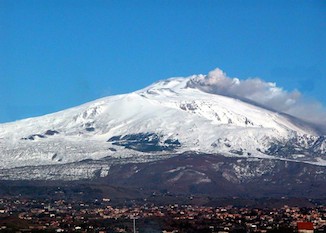
Monte Etna
Etna’s Natural Park stands out for the charming lava flows that constantly change and mark its territory and also for the universe of plants and colours which compose and decompose Mother Nature’s palette, from shades of green of the vineyards , yellow of the apple orchards and brown of the chestnut forests and oak, beech and birch trees as we go upper, where the clouds caress the lava ejected from the bowels of the Earth..Here, in the woods of oaks and ferns, there are extraordinary forms of life which live on what the fire giant lets grow on its slope.
You can still find animals like the wild cat, the fox, the porcupine, the weasel, the dormouse and lots of birds like the peregrine falcon, the owl, the sparrowhawk, the heron and the wild pigeons, but the queen of this area is the superb Golden Eagle.
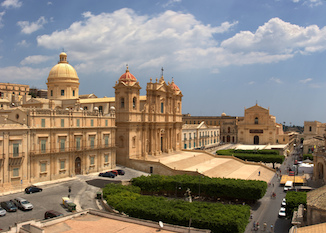
Noto
Noto is believed to have been founded by people Sicani, at the time of the fall of Troy. The story of Noto was determined not so much by men as by nature: in 1693 it was destroyed by the earthquake that struck the south-western part of Sicily. Conceived as a large theater without wings, as a vibrant and flowing, Noto returned to life, sumptuous and superb hillside Meti. The architectural history of the new city were dominated by three architects, Rosario Gagliardi, Vincenzo Sinatra and Paul Labisi, who have managed to develop an incredible masterpiece that shows the architectural unity.
The triumphal arch, along the main path, marks the beginning of the city. Surmounted by three symbolic sculptures
- A crenellated tower (power)
- A dog (fidelity)
- A pelican (sacrifice).
The gate was built in typical real golden limestone used in the previous century to build churches and palaces of the city.
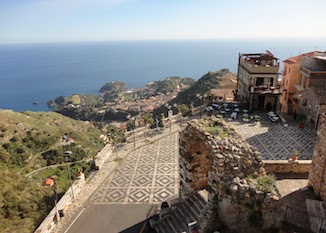
Castelmola
The perched village of Castelmola worth a careful visit. Located on the rock overlooking Taormina and the opportunity to enjoy an even broader view, overlooking the coast which extends south to the majestic volcano Etna and Catania, enchants with its narrow streets and buildings typical of a medieval structure.
We recommend a trip to the Caffè Turrisi, unique not only for the serving of almond wine but also for its riotous peculiarities secret that will not reveal but we invite you to discover for yourself.
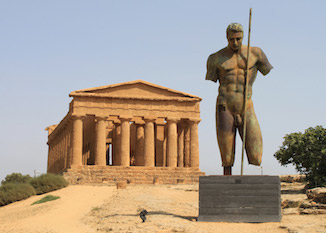
Agrigento
The Temple of Concordia can be seen just peeking out from the southern end of this plain which is green and covered with flowers; some rests of the temple of Juno can be seen if you look towards east and the ruins of all the sacred buildings are in the same line of the above mentioned temples.
Nowadays, only a small part of the landscape, admired by Goethe in 1787, has changed and the Valley of Temples is the most popular and praised part of Agrigento. Inside the Valley, there are several monuments; this is what remains of the ancient city of Akragas, which was founded in the sixth century BC by settlers who came from Gela, thus becoming, in a hundred years, "the mortals’ most beautiful city" (Pindaro).Destroyed by the Carthaginians in 406, was refounded by Timoleonte in 340 BC. Under his control, the city had new moments of brilliance, even if he was heading for the decline, which has become final with the Byzantines.
The old part of the city was abandoned in the ninth century, after the Arab conquest, and the urban core was limited to a hill which took the name of Gergent. Then it was conquered by the Normans, the city became a diocese and several churches were built in it. Buildings and monuments were built during the fourteenth and fifteenth centuries and again during a period included between the seventeenth and eighteenth centuries.
In 1927, the city took the name of Agrigento and today has 56,000 inhabitants. You need a whole day to visit the city.
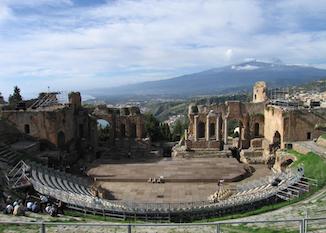
Taormina
His fortune began in the nineteenth century, when, after Goethe’s visit, who praised its beauty throughout Europe, it became almost a must in the "Grand Tour".One of the most important monuments is the “Teatro Antico”, not only for its artistic value, but also for its picturesque location. The panorama from above has been defined as "something to do" once you are in Sicily. It is the second largest ancient theatre of the island (109m diameter), after Syracuse’s one. Modified and extended around 300 years later, it was used by the Romans for gladiatorial combats. The theatre nowadays is used for musical and theatrical performances during summer time. The Romans also built the Odeon, a small building behind the church of Santa Caterina, and Naumachia, a large terrace of protection, with a cistern no longer existing. It seems that the naval battles took place there.
“Corvaja Palace”, built in the fifteenth century, was the seat of the Sicilian Parliament in 1410. On the first floor there are large double mullioned windows and the inner courtyard is very picturesque.
The Cathedral, dedicated to St. Nicholas, was built in the thirteenth century. The main portal, surmounted by a small rose window and flanked by two ogival mullioned windows, was made in 1636 in the Renaissance style, while the two lateral portals, from the fifteenth and the sixteenth centuries, are respectively on the left and right sides of the Cathedral.
The elegant “Dukes of Santo Stefano Palace”, built in the fourteenth and fifteenth centuries, is a fine example of Sicilian architecture. It has got three naves and there are inside interesting paintings by Antonino Giuffrè (1436) and a polyptych by Antonello de Saliba (1504).
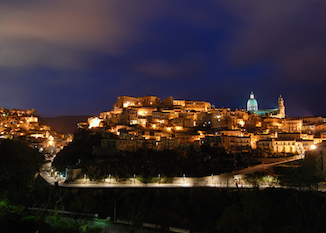
Ragusa - Ibla
The city of Ragusa boasts ancient origins. The hill of Ibla was in fact inhabited since the fourteenth century BC by the Sicilians who left numerous archeological finds in the area (oven tombs, caves dug into the rock. etc ...). From this city passed Greeks, Romans, Dalmatians, Byzantines, Arabs, nonrnanni and Aragonese, who all have helped to forge a cultural retrotenra thick. The city was virtually destroyed by the terrible earthquake that struck 693 in the whole central-eastern Sicily.
Reconstruction began almost immediately, "giving birth" two cities; in fact, the nobles (sangiorgiani) preferred to rebuild on the same site before, while the middle class (sangivannari) wanted to build on the nearby hill of Patro.
It is for this reason that we know that Ragusa is characterized by two urban centers (independent until 1926) practically distinct from the eastern spur is anroccata Ibla which topographical features and urban array of medieval, while to the west (the hill of Patro) is Ragusa develops, characterized by a system more modemo and greater regularity planimetric accentuated by large orthogonal axes.
The reconstruction, which used the materials offered by the very nature of the sites (basalt lava and white stone), gave birth to the jewels of the "flowery baroque" that only rich because of a kind of joyful imagination in 2002 was recognized by 'Unesco world heritage site.
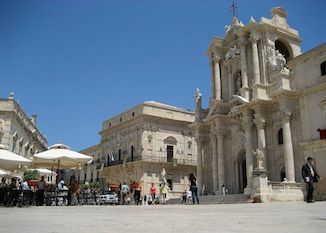
Siracusa
Syracuse was founded in 734 BC by colonists from Corinth. It was one of the largest and most powerful city in the Mediterranean, embellished with temples, palaces, gardens and fountains. It was an ideal city according to Plato, who visited several times, putting it in his hopes for political and social renewal. It was a magnificent city according to Simonides, Pindar, Bacchylides and Aeschylus, who sang her beauty. The Greek Theatre - is the most perfect example of theater architecture which has come down to us and it was one of the largest theaters in the world greek (diameter 138.6 m). We have notices of it from the fifth century BC, when Syracuse was already one of the most important cultural centers of the Mediterranean.
Artistic heritage - Ortigia Temple of Apollo and Artemis - dates back to the seventh century BC and is the oldest greek temple in Sicily. Over the centuries it became a Byzantine church, then a mosque and a Christian basilica. The temple was Doric and show some peculiarities due to its antiquity.
The Cathedral - is in Piazza Duomo, surrounded by elegant Baroque palaces set in an ancient sacred area. The cathedral is the result of successive transformations made to the great temple of Athena, built probably by Diomenides, the family founded by Gelon, the first tyrant of Syracuse. Its magnificence has been celebrated by Cicero. Its doors are made of gold and ivory. On its summit shone the golden shield of Athena.
The Fountain of Arethusa - In a square overlooking the sea, this small fountain, inhabited by ducks and white surrounded by slender papyri, is the symbol of the relationship between Syracuse and the mother city Corinth.
Maniace Castle - It rises imposingly on the seafront of Ortigia. It was built by Frederick II in 1239 The castle, which combines military architecture with the elegance of a court, it still retains the outer structure of the thirteenth century, a square, with massive corner towers.
The Latomies - These are the quarries from which it was obtained the material that was used to build Syracuse. The most interesting is the Latomia paradise, nestled in a lush garden. In it there is the so called "Ear Dionysius", a large artificial cave in which there is an extraordinary acoustic effect of amplification.
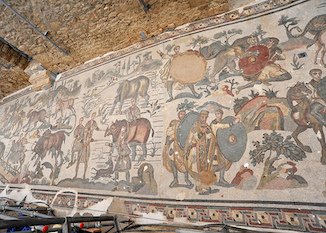
Piazza Armerina
Piazza Armerina is linked to the Roman Villa of Casale, one of the most important archaeological discoveries of Sicily. It was built in the third or fourth century dC by an unknown customer. Whoever it was, the owner of the villa was a very rich man, who loved luxury, convenience, and art. For the decoration of its prestigious country residence that had good mosaic artists who came from Africa for five years and are dedicated to creating beautiful mosaics that still give us a vivid picture of Roman life and mythology.
Covering an area of about 3,500 square meters, there is a sequence of scenes of hunting and dancing, mythological characters and animals, fishing and all kinds of plants and fruits, models, and leader of a style of mosaics in the following centuries it spread in Italy, France and Spain.
Centuries later, Arabs and Normans have lived within these walls, making any changes they thought were necessary to adapt the villa for your needs, but unfortunately damaged the original structure.
In the twelfth century a terrible flood caused a river of mud that, after invading the valley, destroyed the upper part of the villa. The sludge from a side destroyed the ceilings, which must have been splendid, secondly protected the mosaics.
In 1950, the villa has been restored under the guidance of the archaeologist Gino Gentile. The complex consists of four separate groups of buildings, each used for different functions of social life, hospitality, rest, etc.. Under the earth there are still the servants' quarters, stables, warehouses and other buildings.
Of particular interest are the baths, which were composed of different environments, and that, in addition to the mosaics, show traces of the system used to supply water to the Villa; the room of the ten gymnasts with ten women who play various sports activities; the apartments of the ladies of the house, in which, among other things, there is a decoration that shows Odysseus and Polyphemus and the famous "erotic scene."
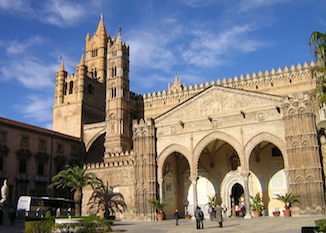
Palermo
Palermo is a city of contrasts. Here you can find the poorest food served in the most elegant tables or you can eat kebab and “stigghiole” at any time of the day or night.Visiting the city's main streets, you can admire the palaces, tangible evidence of an ancient pomp, behind which lies a maze of alleys, courtyards and houses huddled together.
Palermo is also chaos:smoke roast on Sunday morning, cars stuck in traffic behind horse-drawn carriages, “sfincione”’s street vendors, but it is also an elegant, reserved and bourgeois city, perhaps a legacy of the many noble families who lived there and those who, even today, retain the title awaiting for the "Real" di Savoia to come back to visit the city.
Palermo is the hot scirocco which paints the sky with yellow, but also humid evenings in which a light scent of orange, jasmine and Pomelie spreads all around. This is the ancient Panhormus, the "all port" city set in the Conca d'Oro, the beautiful plain surrounded on three sides by mountains and protected by Monte Pellegrino.
Palermo has remained, over the centuries, a multiethnic and multicultural city, thanks to its ability to accommodate, without erasing the traces, the legacy of the rulers who have followed. You may have a tangible sign of this peculiarity through the many city markets, the most famous of whom is certainly the Vucciria.
Palermo’s historic centre has its heart in the octagonal square Vigliena, better known as the Quattro Canti, which is the symbolic geometric centre of Palermo, founded in 1600. The Royal Palace, called "Norman", because it reached its maximum splendor in the Norman period, has got several rooms full of fabulous mosaics, such as “Sala dei Venti”, and “Sala d'Ercole”, where, still nowadays, the Sicilian Parliament gathers. Inside the palace stands the Palatine Chapel, a splendid example of harmony among the different cultures who lived in Sicily, where you can admire the Byzantine mosaics, the wooden ceilings inlaid by the Arabs and the Easter Candelabrum, wonderful sculptural Masterpiece made by Palermo’s craftsmen.
Continuing towards the sea, we will meet, on our left hand side, enclosed between two towers, the majestic Cathedral, which is the evident proof of the various eras and conflicting styles.
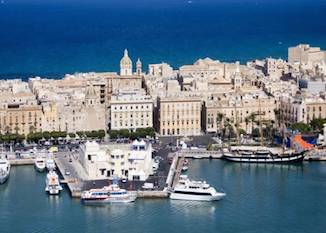
Trapani
A sunset orange, whole Mediterranean, and the skyline in which a distinction is clearly a windmill in the vegetation of the salt marshes. Postcard scenery, one of the many snapshots coming from Trapani, a city in eastern Sicily. The ashlar Jewish Palazzo della Giudecca and the city that extends into the water, view from Mount Erice, are other suggestions of a reality also famous for sailing regattas, to the slaughter of tuna and also be a port convenient for Favignana, Levanzo and Marettimo, the three islands of the Aegean archipelago.
A city that has taken so much from the sea and the sea has also paid duty, by virtue of the numerous invasions: the Carthaginians, coming from the African coast, to the Romans, until you get to the Arabs and the Aragonese. Many conquistadores and their many tracks, Trapani holds that as the memory of old age and puts on display.
Arabs example is the landscape of salt marshes: expanses of brackish water towers and a windmill that was used for grinding salt. Sights to see and photograph, just like the Castle Dovecote, fortification which over the years has changed functions and uses, and which today continues to be one of the five towers that symbolize the city.
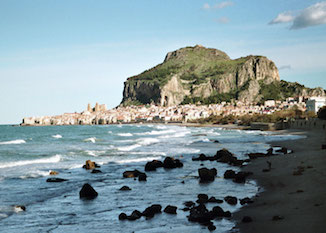
Cefalù
Due to the strategic importance of the place, protected by an imposing rock, as well as the fertility of the land, the people settled in the area from ancient times. However, the urban history of the place began only in the fifth century aC. The name of the Cephaloedium settlement, that is, "head", is given by the fact that the citadel had a dominant position, in fact the term "head" is used because of the shape of the rock is located in the citadel same.
Cefalu has gone through a period of prosperity in the course of the fifteenth century, a period in which it was interrupted by a period of decline in the nineteenth century, from which he has recovered in recent decades, thanks to the booming tourism industry.
The Cathedral (Transfiguration of Our Lord) was founded in 1130 This is without a doubt one of the most beautiful cathedrals in the world, a perfect example of the Romanesque style southern. An important feature of the facade are the two angular towers added in 1240.
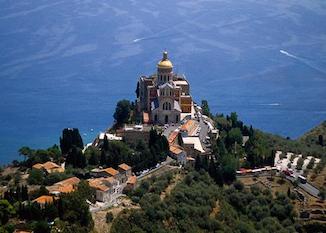
Tindari
Tindari is one of the oldest settlements on the coast of Messina, its foundation dates back to 396 aC the will of the tyrant Dionysius, who wanted to give her the name of Tyndaris devotion to the Dioscuri.Tindari is therefore rich in archaeological remains from the Greek era, are still visible walls, the InsulaRomana an entire neighborhood with spa, housing and a patrician house with splendid remains of mosaics.
Tindari also houses a theater of Greek origin suggestively built to have the extraordinary scenes with the background sea of the Aeolian Islands. It is currently used for performances of an artistic nature.
Impressive: the Shrine of the Black Madonna, constantly pilgrimage to the foot of the fortress of the sanctuary is possible to admire the unique sight of Marinello lakes, a lagoon formed by seven natural pools that form spectacular shapes in the sand.
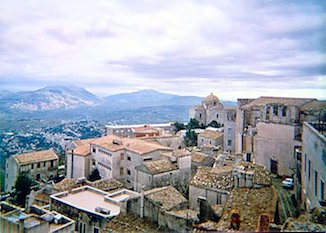
Erice
On top of Mount namesake, on the extreme west coast of Sicily, overlooking the city of Trapani and the sea which reflect, on the one hand the Egadi Islands, the other the Monte Cofano, lies the town of Erice.On a plateau whose fortress culminating reaches 751 meters (above sea level), the village remains almost intact its medieval appearance: the cobbled streets to the stone walls, almost always a protection from the external looks of flowering courtyards which takes place in family life , the feeling you have, along the threads that make up the paved ericini, is an immersion in the remote past.
And, in a tone of gray and the other, you discover evidence of an epoch or another, from the Baroque to the balcony of the majestic Gothic church mother, the powerful Norman architecture lines fifteenth...
The magnificent panoramas from any side you look out, they appear to the visitor - backdrops to the cliffs that surround the cliff - are truly breathtaking: on the one hand, Trapani, salt marshes, Egadi Islands, Marsala and further south, if the weather permitting, even Pantelleria, black pearl in the Strait of Sicily and Cape Bon in Tunisia; the other, the Tyrrhenian Sea, the Gulf of Castellammare, the coast arriving in San Vito lo Capo and over again, until Ustica.
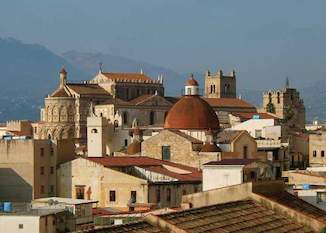
Monreale
At about 8 km from Palermo, in the town of Monreale, located in the beautiful Arab-Norman style cathedral dedicated to the Virgin Mary. The imposing building was built in 1174 at the behest of the Norman King William II as a result of the Madonna appeared in a dream and asked him to build a temple in his honor.
The Cathedral is a porch outside with a three-light window beneath which there is a fine bronze portal by Bonanno Pisano, and two large square towers, one of which turned into a belfry. The interior has a Latin cross is divided into three naves divided by columns topped by beautifully carved capitals; the walls are covered with magnificent mosaics with gold backgrounds of the Byzantine school (XII and XIII sec.) depicting scenes from the Bible and stories of the church.
Among the many treasures stored there deserve mention: the altar by the silversmith Valadier (1711), the sarcophagi of William I and William II, the organ keyboards to six of the twentieth century.
Do not miss the Chapel of the Crucifix, an example of Sicilian Baroque, which guards the treasure of the cathedral with the reliquary containing a thorn from Christ's crown.
Also worth visiting is the cloister arcade of the Benedictine monastery (XII sec.) Next to the cathedral to admire the rich decoration of the capitals of the columns stained.
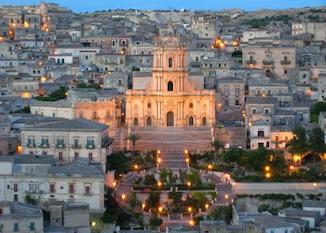
Modica
Modica is one of the most picturesque cities of the province of Sicily. It is located in the southern area of the Iblean mountains and is divided into two areas: Modica Alta, whose buildings are almost climbing the mountain rocks, and Modica Bassa, down in the valley, where once two rivers Ianni Mauro and Pozzo dei pruni, then covered because of frequent floods, and where it is now the Corso Umberto, the main street and historic center of the city.
The aspect is mainly the late Baroque, dating back to the aftermath of the earthquake (1693). What makes the city so unique and fascinating is, first of all, the baroque aspect, of which the urban design and historic center of Modica abound; also the presence of violet and picturesque narrow streets, full of old shops, huts or rich palaces.
It's a great little town, rich in historical and artistic, easily visited on a weekend. I'm sure to see the church of San Giorgio, a wonderful church in Sicilian baroque style.
Of great value is then also the church of San Pietro which has beautiful especially the huge staircase that lies ahead with all the statues of the apostles. Next to the church and the stairs leading to the castle of the Counts and the Clock Tower, you arrive at the church of St. Nicholas Lower, symbol of rock-cut architecture (very nice frescoes inside).
